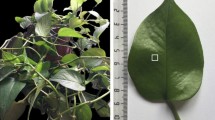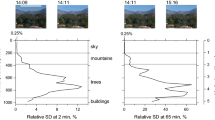Abstract
THE use of transmitted illumination in microscopic studies of chemical or biological material on plant surfaces is limited by the opaqueness of the plant tissues. The methods described by Crisp and Thorpe1 and Bryson2 for obtaining transparent impressions of various surfaces in gelatin and cellulose acetate respectively have been successfully applied to the study of deposits on leaf surfaces. Such impressions can be readily enlarged and examined visually or photographically; simple 35-mm. projection, provides ample magnification for general distribution studies of materials on plants, but for more detailed studies much higher magnification can be used.
This is a preview of subscription content, access via your institution
Access options
Subscribe to this journal
Receive 51 print issues and online access
$199.00 per year
only $3.90 per issue
Buy this article
- Purchase on Springer Link
- Instant access to full article PDF
Prices may be subject to local taxes which are calculated during checkout
Similar content being viewed by others
References
Crisp, D. J., and Thorpe, W. H., Nature, 165, 273 (1950).
Bryson, H. Courtney, Lab. Practice, 3, 377 (1954).
Author information
Authors and Affiliations
Rights and permissions
About this article
Cite this article
BENNETT, S., FURMIDGE, C. Impression Methods for the Study of the Distribution of Deposits and Organisms on Plant Surfaces. Nature 178, 152–153 (1956). https://doi.org/10.1038/178152a0
Issue Date:
DOI: https://doi.org/10.1038/178152a0
This article is cited by
-
Approaches to the identification of angiosperm leaf remains
The Botanical Review (1974)
-
Leaf-clearing Technique to assist Fungal Spore Germination Counts
Nature (1962)
-
A Technique for measuring Structural Features of Plant Epidermis using Cellulose Acetate Films
Nature (1956)
Comments
By submitting a comment you agree to abide by our Terms and Community Guidelines. If you find something abusive or that does not comply with our terms or guidelines please flag it as inappropriate.



